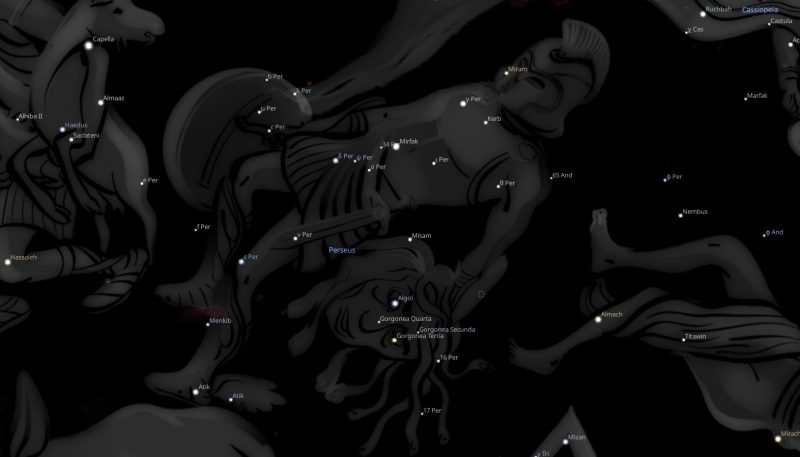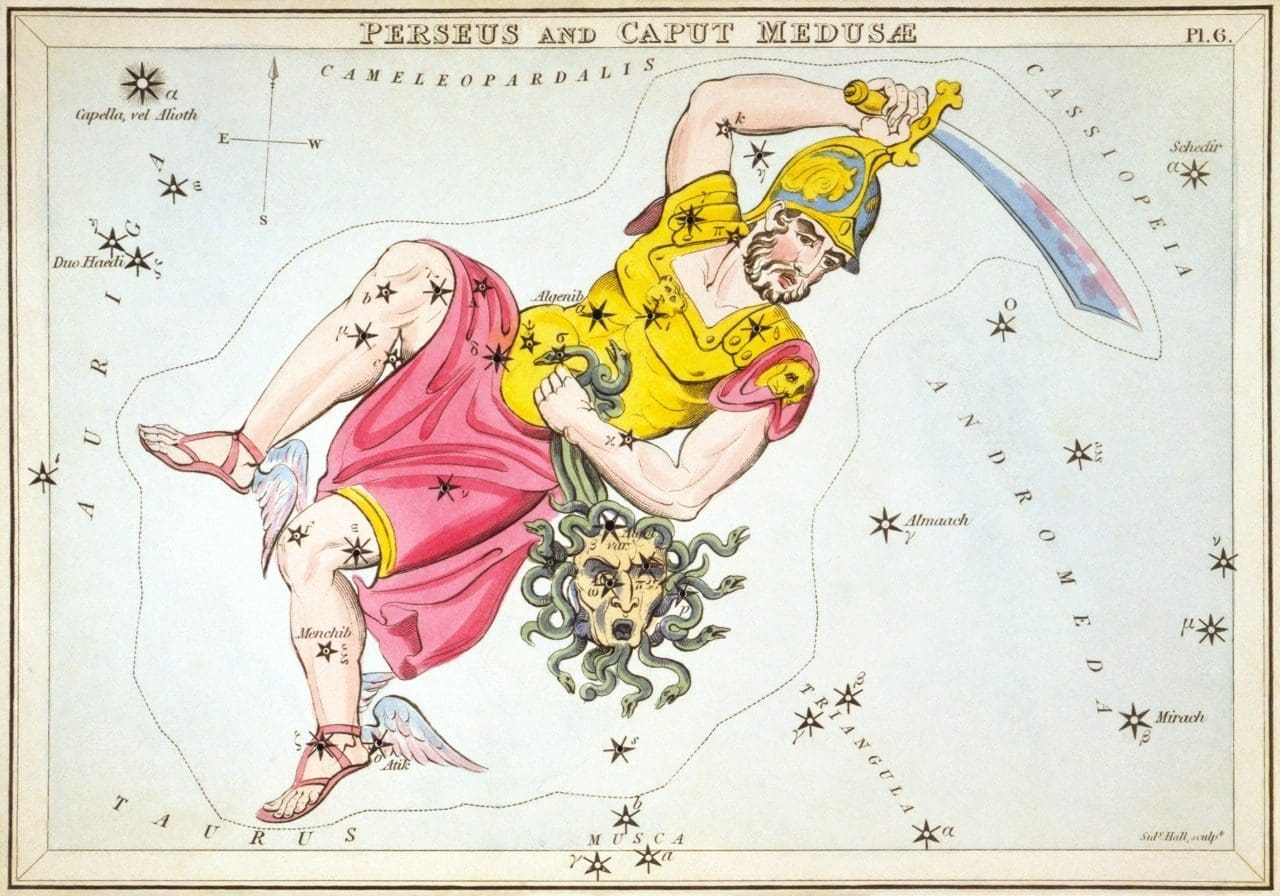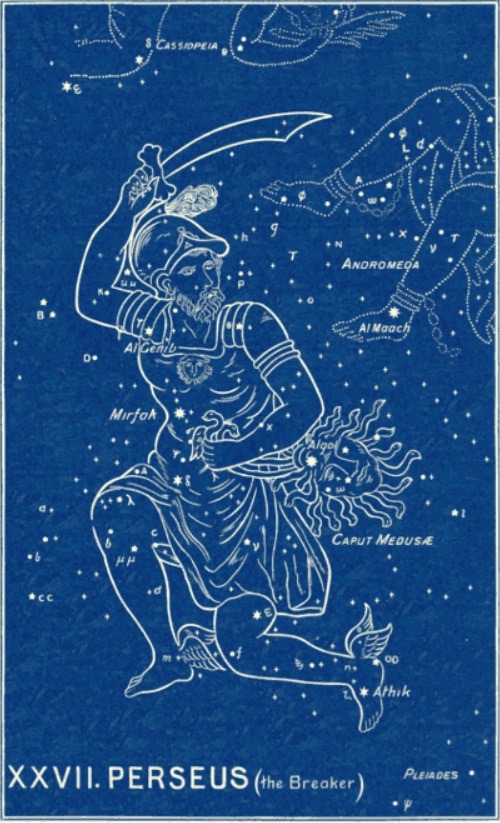FIXED STARS: Major Stars | 1000+ Stars | Constellations | About
Constellation Perseus the Champion is a northern constellation bordering Aries, Taurus, Auriga, Camelopardalis, Cassiopeia, Andromeda, Triangulum and the obsolete constellation Musca Borealis.Perseus is one of the 48 constellations listed by Ptolemy in the 2nd century and remains one of the 88 modern constellations. It spans over 40 degrees of the zodiac in the Signs of Taurus and Gemini.
Abbreviation: Per
Genitive: Persei
Perseus Constellation Stars
| 2000 | 2050 | Star | Name | Sp. Class | Mag. | Orb |
|---|---|---|---|---|---|---|
| 14♉36 | 15♉18 | φ Per | Seif Borealis | B2 | 4.01 | 1°20′ |
| 20♉57 | 21♉40 | 17 Per | K5 | 4.56 | 1°10′ | |
| 21♉45 | 22♉27 | M34 | Capulus | 5.50 | 1°00′ | |
| 23♉54 | 24♉37 | π Per | Gorgonea Secunda | A2 | 4.68 | 1°00′ |
| 24♉46 | 24♉58 | χ Per | Misam al Thurayya I | G7 | 5.99 | 1°00′ |
| 24♉55 | 25♉37 | ρ Per | Gorgonea Tertia | M3 | 3.32 | 1°40′ |
| 26♉10 | 26♉52 | β Per | Algol | B8 | 2.09 | 2°10′ |
| 26♉22 | 27♉04 | ω Per | Gorgonea Quarta | K1 | 4.61 | 1°00′ |
| 27♉42 | 28♉24 | κ Per | Misam | K0 | 3.79 | 1°30′ |
| 27♉55 | 28♉37 | τ Per | Kerb | G4 | 3.93 | 1°30′ |
| 28♉42 | 29♉24 | η Per | Miram | K3 | 3.77 | 1°30′ |
| 29♉18 | 00♊00 | ι Per | G0 | 4.05 | 1°20′ | |
| 00♊05 | 00♊44 | γ Per | Alphecher | G8 | 2.91 | 1°50′ |
| 01♊10 | 01♊52 | ο Per | Atik | B1 | 3.84 | 1°30′ |
| 02♊05 | 02♊47 | α Per | Mirfak | F5 | 1.79 | 2°20′ |
| 02♊26 | 03♊08 | 42 Per | Tiānchán | A3 | 5.14 | 1°00′ |
| 03♊08 | 03♊50 | ζ Per | Atik | B1 | 2.84 | 2°00′ |
| 06♊45 | 04♊27 | ψ Per | Seif Australis | B5 | 4.32 | 1°10′ |
| 03♊50 | 01♊32 | ν Per | Adid Media | F5 | 3.77 | 1°30′ |
| 04♊48 | 05♊31 | δ Per | Adid Borealis | B5 | 3.01 | 1°50′ |
| 04♊59 | 05♊41 | ξ Per | Menkib | O7 | 3.98 | 1°30′ |
| 05♊41 | 06♊23 | ε Per | Adid Australis | B0 | 2.90 | 1°50′ |
| 09♊30 | 10♊12 | 48 Per | B3 | 3.96 | 1°30′ | |
| 09♊45 | 10♊27 | λ Per | Jīshuǐ | A0 | 4.25 | 1°20′ |
| 10♊48 | 11♊30 | μ Per | G0 | 4.12 | 1°20′ | |
| 13♊35 | 14♊17 | 58 Per | G8 | 4.25 | 1°20′ |
Perseus Astrology
Robson
Legend. Perseus, the son of Jupiter and Danæ, was furnished with the sword, cap and wings of Mercury and the shield of Minerva. He killed the Medusa by cutting off her head and afterwards rescued and married Andromeda. On his return home he inadvertently killed his grandfather Acrisius and pined away through grief, whereupon Jupiter took pity on him and placed him among the stars.
Influence. According to Ptolemy, Perseus is like Jupiter and Saturn. It is said to give an intelligent, strong, bold and adventurous nature, but a tendency to lying. By the Kabalists it is associated with the Hebrew letter Lamed and the 12th Tarot Trump “The Hanged Man.”
Magical. Frees from envy and witchcraft and preserves from lightning and tempests. [1]
Noonan
The constellation is indicative of events affecting large numbers of people, especially those events caused by major meteorological phenomena. [2]
Perseus Constellation [Urania’s Mirror]
Allen
Perseus, the Champion.. formerly was catalogued as Perseus et Caput Medusae.
He is shown in early illustrations as a nude youth wearing the talaria, or winged sandals, with a light scarf thrown around his body, holding in his left hand the Gorgoneion, or head of Medusa-Guberna, the mortal one of the Gorgons, and in his right the ἅρπη, or falx, which he had received from Mercury.
A title popular at one time, and still seen, was the Rescuer, for, according to the story, Perseus, when under obligations to furnish a Gorgon’s head to Polydectes, found the Sisters asleep at the Ocean; and, using the shield of Minerva as a mirror, that he might not be petrified by Medusa’s glance, cut off her head, which he then utilized in the rescue of Andromeda.
His story probably was well known in Greece anterior to the 5th century B.C., for Euripides and Sophocles each wrote a drama based on Andromeda’s history; and with them, as with the subsequent Greeks, he was Περσεύς, a word that may be derived from the Hebrew Pārāsh, a Horseman, although Ctesias, in his Περσικά of about 400 B.C., had Parsondas as a stellar name from Babylonia that may be this. Parasiea, current in late Indian astronomy, is only another form of the Greek original.
Ἱππότης, the Horseman, and Profugus, the Flying One, also are titles for these stars.
La Lande identified the figure with the Egyptian Khem, and with Mithras of Persia, Herodotus having asserted [II.91] that Perseus, through his and Andromeda’s son Perses, gave name to that country and her people, who previously were the Chephenes, as descended from Chepheus, the son of Belus, identified by some with the Cepheus of the sky. The kings of Cappadocia and of Pontus, similarly descended, represented the Hero on their coins.
Cacodaemonb was the astrologers’ name for this constellation, with special reference to Algol as marking the demon’s head; while Schickard, Novidius, and the biblical school generally said that it was David with the head of Goliath; but others of the same kind made of it the Apostle Paul with his Sword and Book. Mrs. Jameson thought that the legend of Perseus and Cetus was the foundation of that of Saint George and the Dragon, one version making this saint to have been born at Lydda, only nine miles from Joppa, the scene of Perseus’ exploit.
The constellation is 28° in length, — one of the most extended in the heavens, — stretching from the upraised hand of Perseus nearly to the Pleiades, and well justifying the epithet περιμήκετος, “very tall,” applied to it by Aratos. It offers a field of especial interest to possessors of small telescopes, while even an opera-glass reveals much that is worthy of observation. Argelander gives a list of 81 naked-eye stars, and Heis 136.
The former has suggested that within its boundaries may lie the possible central point of the universe, which Mädler located in the Pleiades and Maxwell Hall in Pisces, — all probably unwarranted conclusions.
δ, ψ, σ, α, γ, η, and others on the figure’s right side, form a slight curve, open towards the northeast, that has been called the Segment of Perseus. [3]
Bullinger
Here we have set before us a mighty man, called in the Hebrew Peretz, from which we have the Greek form Perses, or Perseus (Rom 16:13). In the Denderah Zodiac His Name is Kar Knem, he who fights and subdues. It is a beautiful constellation of 59 stars, two of which are of the 2nd magnitude, four of the 3rd, twelve of the 4th, etc.
Their names supply us with the key to the interpretation of the picture. The star α (in the waist) is called Mirfak, who helps. The next, g (in the right shoulder), is named Al Genib, which means who carries away. The bright star in the left foot is called Athik, who breaks!
In his left hand he carries a head, which, by perversion, the Greeks called the head of Medusa, being ignorant that its Hebrew root meant the trodden under foot. It is also called Rosh Satan (Hebrew), the head of the adversary, and Al Oneh (Arabic), the subdued, or Al Ghoul, the evil spirit. The bright star, β (in this head), has come down to us with the name Al Gol, which means rolling round.
It is a most remarkable phenomenon that so many of these enemies should be characterised by variable stars! But this head of Medusa, like the neck of Cetus, has one. Al Gol is continually changing. In about 69 hours it changes from the 4th magnitude to the 2nd. During four hours of this period it gradually diminishes in brightness, which it recovers in the succeeding four hours; and in the remaining part of the time invariably preserves its greatest lustre. After the expiration of this time its brightness begins to decrease again. Fit emblem of our great enemy, who, “like a roaring lion, goeth about seeking whom he may devour” (1 Peter 5:8); then changing into a subtle serpent (Gen 3:8); then changing again into “an angel of light” (2 Cor 11:14). “Transforming himself” continually, to devour, deceive, and destroy. [4]
References
- Fixed Stars and Constellations in Astrology, Vivian E. Robson, 1923, p.56, 232.
- Fixed Stars and Judicial Astrology, George Noonan, 1990, p.14.
- Star Names: Their Lore and Meaning, Richard H. Allen, 1889, p.329-335.
- The Witness of the Stars, E. W. Bullinger, 1893, Perseus (the Breaker).


